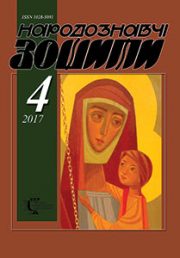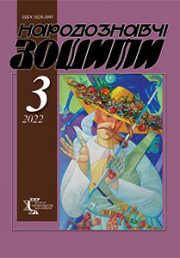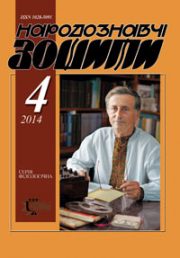The Ethnology Notebooks. 2023. № 1 (169), 58—69
UDK 930.2:[392.1:392.51](477.86=161.2)
DOI https://doi.org/10.15407/nz2023.01.058
CUSTOMS, RITES AND BELIEFS, ASSOCIATED WITH THE CHURCH WEDDING OF THE NEWLYWEDS IN POKUTTIA
HOROSHKO-POHORETSKA Lesya
- ORCID ID: http://orcid.org/0000-0002-8741-2467
- Candidate of Historical Sciences (= Ph.D. in history),
- Senior Researcher at the Ethnology Institute
- of National Academy of Sciences of Ukraine,
- Svobody Avenue, 15, 79000, Lviv, Ukraine,
- Contacts: e-mail: horoshyna@gmail.com
Abstract. The relevance of the mentioned topic is evidenced by the living existence of the wedding ceremony in the Ukrainian tradition. Therefore, the purpose of the article is to consider a complex of customary and worldview phenomena related to the creation of a new family. The object of the study is the traditional worldview and custom-ritual culture of the inhabitants of Pokuttia, and the subject is the customs, rites and beliefs, associated with the church wedding of the newlyweds in Pokuttia. Among the pre-marriage rites the father’s blessing and the last dance of the newlyweds, sprinkling with holy water and grain (sugar) of the young couple are described. The road to the church was accompanied by a number of customary and worldview realities, which aimed to ensure a happy fate for the future spouses (lining up of wedding guests, leading the newlyweds out of the house on a canvas, moving «after the sun», bowing to fellow villagers, etc.). The omens that, according to the beliefs of the inhabitants of Pokuttia, could indicate the fate of the future couple (burning candles, falling of a wreath, crown, necklace, shawl, or the bride’s ring), as well as magical actions by which the newlyweds tried to secure the headship of the family, were also analyzed (squatting on the clothes of the chosen one, tearing the kalach, etc.).
The basis for the research are the materials of the author’s field research during 2013—2014 in the villages of Kolomyjsky, Gorodenkivsky, Sniatynsky, Tlumatsky and Tysmenytsky districts of Ivano-Frankivsk oblast, and works of the end of nineteenth and the beginning of twenty-first centuries. The methodology of this work is based on general scientific methodological principles and the basic requirements that apply to the works of historical and ethnological direction.
It was found out that the ethnolocal version of the wedding customs of Pokuttia has specific Ukrainian features. At the same time it conserves the distinctive manifestation.
Keywords: church wedding, wedding, newlyweds, groom, bride, Pokuttia.
Received 19.12.2022
REFERENCES
- Wedding in Kolomyja district. Retrieved from: https://www.facebook.com/watch/?v=5515955581856457 (Last accessed: 4.11.2022) [in Ukrainian].
- Waigiel, L. (1877). Essay of the city of Kolomyia. Kolomyia [in Polish].
- Kolberg, O. (Ed.). (1961). Pokucie. In Kolberg, О. All works (Vol. 29, p. 1). Wroclaw; Poznan: Polskie Wydawnictwo Muzyczne; Ludowa Spoldzielnia Wydawnicza [in Polish].
- Mroczko, K.Fr. (1897). Sniatynszczyzna (A contribution to national ethnography). Scientific and literary guide, 4 (Vol. XXV, pp. 289—304; 5, 385—402; 6, 481—498; 7, 577—595) [in Polish].
- Golubovycheva, O. (1919). Wedding in the village Ilyntsi, Sniatyn district. Materials for Ukrainian ethnology (Vol. ХІХ—ХХ, pp. 177—193) [in Ukrainian].
- Voloshynsky, I. (1919). Wedding in Daleshiv, Horodensky district. Materials for Ukrainian ethnology (Vol. ХІХ—ХХ, pp. 2—34) [in Ukrainian].
- Ravliuk, V. (Ed.). (1970). Wedding in the village of Orelets’, Sniatynskyj district in Stanislavskyj Region. 1890. In Wedding: in 2 books(Book 2, pp. 183—214). Kyiv: Naukova dumka [in Ukrainian].
- Pokuttia’s wedding. (1970). Text and melodies recorded by M.V. Gushul in the village of Rozhniv, Kosivskyj district, Ivano-Frankivsk region. 1968. In Wedding: in 2 books(Book 2, pp. 426—463). Kyiv: Naukova dumka [in Ukrainian].
- Pankiv, M.I. (1988). Family and family life on Pokutye (1850—1980). (Candidate dissertation). Archive of the IN NANU (Archive of the Institute of Ethnology of the National Academy of Sciences of Ukraine). F. 1. Op. 2. Od. save 355 b. Arc. 1—188 [in Russian].
- Pankiv, M. (2000). Wedding in the village of Verbivtsi in Gorodenkivshchyna. Ivano-Frankivsk: Lileja-NV [in Ukrainian].
- Pankiv, M. (2011). Wedding attributes of Pokuttia. Yamhoriv, 18—19, 228—233 [in Ukrainian].
- Niemiets, V. (2014). Small tree as a subject-symbolic component of the wedding ritual: the Volyn-Pokuttia parallels (on materials from the Radekhivskyj and Bogorodchanskyj districts). Actual problems of national and world history: Collection of scientific works: Scientific notes of Rivne State Humanitarian University (Issue 25, pp. 185—186). Rivne: Zen’ O. [in Ukrainian].
- Gerus, L. (2017). «Kolach» in the wedding ceremony of the inhabitants of Pokuttia of the end of nineteenth and the beginning of twenty-first centuries: a plastic solution, symbolism, functions. The Ethnology notebooks, 1, 160—170 [in Ukrainian].
- Konopka, V. (2019). Wedding rite in Pokuttia (ethnographic materials from the village Dolishnie Zaluchchia of Sniatyns’kyi district and the village Potochyshche of Horodenkivs`kyi district, Ivano-Frankivs`k region). The Ethnology notebooks, 5 149), 1342—1357 [in Ukrainian].
- Serebryakova, O.H. (2013). Pokuttia (field materials, collected in Kolomyjs`kyj and Snyatins’kyj districts, Ivano-Frankivs’k oblast’). Archive of the IN NANU. F. 1. Op. 2. Od. save 704. Arc. 1—51 [in Ukrainian].
- Serebryakova, O.H. (2014). Pokuttia (field materials, collected in Tlumats’kyj, Tysmenyts’kyj and Horodenkivs’kyj districts, Ivano-Frankivs’k oblast’). Archive of the IN NANU. F. 1. Op. 2. Od. save 771. Arc. 1—175 [in Ukrainian].
- Serebryakova, O.H. (2016, 2017). Pokuttia (field materials, collected in Horodenkivs’kyj district, Ivano-Frankivs’k oblast’). Archive of the IN NANU. F. 1. Op. 2. Od. save 782. Arc. 1—253 [in Ukrainian].
- Boychuk, K. (2017). Wedding ceremony of Horodenkivshchyna (based on the materials of the expedition in 2016). The Ethnology notebooks, 1, 154—159 [in Ukrainian].
- Horoshko, L.M. (2013). Field materials from Pokuttia (Kolomyjs’kyj, Horodenkivs’kyj, Tlumats’kyj, Snyatins’kyj districts, Ivano-Frankivs’k oblast’). Archive of the IN NANU. F. 1. Op. 2. Od. save 698. Arc. 1—116 [in Ukrainian].
- Horoshko-Pohoretska, L.M. (2014). Field materials from Pokuttia (Tlumats’kyj, Tysmenyts’kyj, Horodenkivs’kyj districts, Ivano-Frankivs’k oblast’). Archive of the IN NANU. F. 1. Op. 2. Od. save 736. Arc. 1—97 [in Ukrainian].
- Horoshko-Pohoretska, L. (2019). Press sack to sack, and bag to bag [«Tulysia mich do micha, a torba do torby»] (pre-wedding customs in Pokuttia). The Ethnology notebooks, 3 (147), 580—590 [in Ukrainian].
- Andrusiak, S., Bilyj, D., Dvoiak, M. & Kachorak, Y. (Eds.). (2007). Vikniany: from the past to the present. Lviv: Ukrajins’ki technologiji [in Ukrainian].
- Vozniak, V. (2003). My village — Ukraine’s blossom. Ivano-Frankivsk: Nova Zoria [in Ukrainian].
- Gachynskyj, M. (2006). Essay of the history of the village Petriv. Ivano-Frankivsk: Nova Zoria [in Ukrainian].
- Grabovetskyj, V. (2001). Ivanivtsi. The chronicle of the village over the Prut. Ivano-Frankivsk: Nova Zoria [in Ukrainian].
- Drabchuk, I. (2008). The wedding of Silets’. Ivano-Frankivsk: SIMYK [in Ukrainian].
- Zhybak, G. & Khimej, R. (Eds.). (2010). Traditional Ukrainian rites and customs (wedding, christening, hajivky). Ivano-Frankivsk: Misto NV [in Ukrainian].
- Zholobajlo, Y. (2000). «This is Matijivtsi — our village…»: Historical and ethnographic essay. Kolomyja: Vik [in Ukrainian].
- Kostiv, V. (Ed.). (2000). The History of Ugryniv. Essays of the history of the village of Ugryniv in the Tysmenytsia district of Ivano-Frankivsk region. Ivano-Frankivsk: Plaj [in Ukrainian].
- Koguch, B. & Sas, O. (1998). Essays of the history of the village of Pavelcha (Pavlivka). Ivano-Frankivsk: Lik [in Ukrainian].
- Korol’ko, O. (2008). Wedding ceremonial and customary traditions of Pokuttia and Hutsul’shchyna at the beginning of the 20th century: comparative survey. Sniatyn, Sniatyn’schina: History and Present. Materials of the scientific and practical conference devoted to the 850th anniversary of the city of Snyatyn in Pokuttia (Pp. 77—84). Sniatyn: PrutPrint [in Ukrainian].
- Marusyk, P. (2000). «Beleluje, my cradle!» History, ethnography, life of Pokuttia’s village. Halych [in Ukrainian].
- Petruk, M. & Petruk, P. (2000). The history of Tovmachyk: Historical and ethnographic essay. Kolomyja: Vil’nyj holos [in Ukrainian].
- Marchuk. V., Korol’ko, A., Kozholianko, G., Sukhyj, A., & Nagirnyj, V. (Eds.). (2010). Pokuttia: Historical and Ethnographic Essay. Lviv: Manuscrypt [in Ukrainian].
- Slobodian, N. (2008, 2009). Hrynivtsi’s wedding. Yamhoriv, 15, 172—216; 16—17, 220—225 [in Ukrainian].
- Sorych, M. (2000). The History of Myshyn. Kolomyja [in Ukrainian].
- Stryzhevska, N. (2006). Modern wedding in Sopiv. Materials of the round-table local lore «Kolomyjs’ka Hutsul’shchyna» (Pp. 68—74). Kolomyja [in Ukrainian].
- Tafijchuk, M. (2006). Kluchiv’s wedding wreath. Materials of the round-table local lore «Kolomyjs’ka Hutsul’shchyna» (Pp. 36—38). Kolomyja [in Ukrainian].
- Tsyperdiuk, M. (2004). The Village over Golden Bystrycia. Ivano-Frankivsk: Lileja-NV [in Ukrainian].
- Denys, S.V. (Ed.). Wedding rites of village Isakiv (handwriting) [in Ukrainian].
- Local history. Retrieved from: https://www.facebook.com/ LokalnaIstoria/photos/pb.173162079529892.-2207520000.1473157423./568747603304669/?type=3&theater (Last accessed: 14.03.2016).
- Borysenko, V. (1994). Wedding customs and ceremonies. In Podillia: historical and ethnographic research(Pp. 217—228). Kyiv: Dolia [in Ukrainian].
- Borysenko, V. (1988). Wedding customs and ceremonies in Ukraine: historical and ethnographic research. Kyiv: Naukova dumka [in Ukrainian].
- Bosyk, Z. (2010). Family rituals: Transformation and archetypical motives of wedding ceremonies of the Middle Dnipro region: monograph. Kyiv: NAKKKIM [in Ukrainian].
- Guzii, R., Warhol, N., Warhol, J., & Ostapyk, O. (2002). Wedding ceremonies. In Lemkivshchyna: historical and ethnographic research (Vol. 2: Spiritual culture, pp. 75—93). Lviv: IN NANU [in Ukrainian].
- Zdoroveha, N. (1974). Essays of folk wedding ceremonies in Ukraine. Kyiv: Naukova dumka [in Ukrainian].
- Zdoroveha, N. (1983). National customs and rites. In Boy kivschyna: historical and ethnographic research (Pp. 232—248). Kyiv: Naukova dumka [in Ukrainian].
- Kushnir, V. & Petrova, N. (2008). Traditional wedding ceremony of the Ukrainians of the Odesa region (20—80’s of the twentieth century). Odesa: Hermes [in Ukrainian].
- Siavavko, E. (1987). Family Rites. In Hutsul’shchyna: historical and ethnographic research (Pp. 302—319). Kyiv: Naukova dumka [in Ukrainian].







